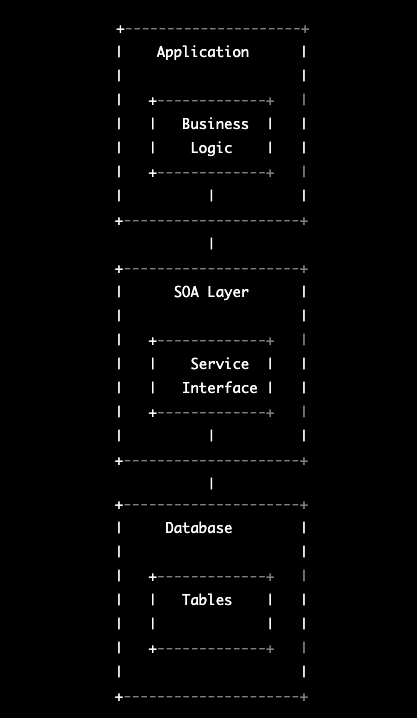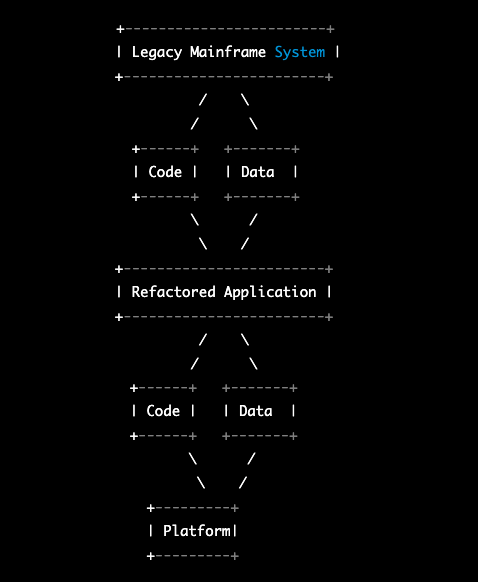Modernize Mainframe Assets & Empower Your Business
Revolutionize your Legacy Mainframe Workloads with our Digital Transformation, Consulting and Support Services thus delivering to your business needs with agility

Introduction
Are you tired of being held back by outdated Mainframe technology? SPARK+ Technology's Mainframe Application Modernization Practice offers cutting-edge digital transformation services to help you take your Mainframe workloads to the next level. Our team of Mainframe Consultants/Advisors, with over three decades of experience in Mainframe technologies and solution architecture, is here to help you achieve your business goals
Expertise
Our team of Mainframe Consultants/Advisors has extensive expertise in Mainframe technologies and has worked in multiple domains of multinational corporations. We use our deep industry knowledge to guide clients through a digital transformation journey that is tailored to their specific needs and challenges. With our proven modernization tools and techniques, as well as the latest agile DevOps approaches, we can help you modernize your Mainframe workloads quickly and efficiently
Services
Training
- Cloud Technologies – AWS, Devops, AWS Certification guidance, hackatons, quizzes, bootcamps.
- Mainframe Z/OS based intensive training covering Z/OS basics, JCL, VSAM, CICS, DB2, IMS DB, Cobol using Microfocus and VS IDE
- Enterprise Java
- Converting Cobol to Java
- Blockchain Technologies
- Specialized bespoke training for corporates/enterprises on any of the above
Consultancy and Solutioning
SPARK+ provides value-added consulting to assist clients in developing solution roadmaps and executing cost-effective mainframe migrations.
Skilled Manpower Development
SPARK+ has deployed Skilled and experienced Manpower for projects involving Java and Mainframe Technologies.
End-to-End Project Development
End-to-End Project development, enhancements and production support on turn-key basis executed from our offshore development center.
Quality Testing
Quality Testing of Mainframe Applications (unit test, system test, integration test) based Client Requirements.
What is Modernization
Modernization can have different meaning based on the impacted area of technology change. But the underlying driving factor is for the enterprise to adapt to business needs with agility and scalability. Modernization can mean an upgrade to existing Mainframe Infrastructure, or it can be an added functionality to an application to enable web traffic, or it can be to take advantage of services available by cloud providers in terms of data analytics, Machine Learning, AI use cases by leveraging the vast data available on Mainframes (Hybrid Cloud). Modernization, impacts not just those workloads that are transformed, but also the back-end processes/personnel who may need to be retrained/reskilled. SPARK+ vast experience in all facets of digital transformation footprint will help you in your journey of Modernization
Encapsulating
ReArchitecting
ReHosting
ReFactoring
Encapsulating
Encapsulating is a technique in modernizing mainframe applications that involves isolating certain functionality or data within a module or component, such that it can be easily maintained, updated, or replaced without affecting the rest of the system
In a mainframe modernization context, encapsulation can be applied to different aspects of the system, such as data, business logic, user interface, and integration. The following is an example of how encapsulation can be used to modernize a mainframe application's data layer.
Architecturally, the mainframe application may have a monolithic database with multiple tables that are accessed by different parts of the system. In a modernization effort, the data layer can be encapsulated by introducing a service-oriented architecture (SOA) layer that exposes the database tables as services to other parts of the system. The SOA layer acts as an intermediary between the database and the rest of the system, and provides a well-defined interface that shields the database implementation details from the calling components.
The following diagram shows an example of this architecture:

In this architecture, the application uses the services provided by the SOA layer to access the database tables. The SOA layer shields the application from the database implementation details, such as the table structure and SQL queries, and provides a standardized interface that can be easily updated or replaced without affecting the application.
Encapsulating the data layer in this way can also provide benefits such as improved performance, scalability, and security, as the SOA layer can apply caching, load balancing, and security policies to the database access.
Rearchitecting
Rearchitecting legacy mainframe systems involves modernizing outdated software applications that were designed to run on mainframe computers. Mainframe systems are still widely used by largescale business and government applications, but many of these systems are now outdated and no longer meet the needs of modern organizations. Rearchitecting these systems involves updating their architecture to improve performance, scalability, and maintainability.
- Moving from a monolithic architecture to a microservices architecture: A monolithic mainframe system is one in which all the application logic and data are tightly coupled and run on a single mainframe computer. This can make it difficult to scale the system and maintain it over time. By contrast, a microservices architecture involves breaking the application down into smaller, independent services that can be deployed and scaled separately. This can improve scalability and make it easier to maintain the system over time.
- Adopting a cloud-based architecture: Many legacy mainframe systems were designed to run on dedicated mainframe hardware, which can be expensive to maintain and upgrade. By adopting a cloud-based architecture, organizations can take advantage of cloud computing resources, which can be more cost-effective and scalable. This involves rearchitecting the legacy mainframe application to run on a cloud infrastructure, which can require significant changes to the application’s architecture and code.
- Replacing outdated programming languages and tools: Many legacy mainframe systems were developed using outdated programming languages and tools that are no longer widely used. For example, COBOL is a popular programming language for mainframe systems that was first introduced in the 1960s. While COBOL is still used in many mainframe applications today, it can be difficult to find developers with expertise in the language. Rearchitecting a legacy mainframe system may involve replacing outdated programming languages and tools with more modern alternatives that are easier to maintain and support.
- Introducing modern user interfaces: Many legacy mainframe systems were designed with text-based user interfaces that can be difficult to use and navigate. Rearchitecting a legacy mainframe system may involve introducing modern user interfaces that are more intuitive and user-friendly. This can involve rearchitecting the system to support web-based interfaces or mobile applications.
Here are some examples of rearchitecting legacy mainframe systems:
In conclusion, rearchitecting legacy mainframe systems involves modernizing outdated software applications that were designed to run on mainframe computers. This can involve moving to a microservices architecture, adopting a cloud-based architecture, replacing outdated programming languages and tools, and introducing modern user interfaces.
Rehosting
In the context of legacy mainframe modernization, rehosting refers to the process of moving an existing mainframe application to a new platform while preserving its existing functionality, business rules and data. This is typically done to modernize legacy systems, reduce costs, increase flexibility and take advantage of newer technologies.
Rehosting can involve various approaches such as moving the application to a new hardware environment or cloud platform, translating mainframe code to a modern language or using emulation or virtualization techniques to run the application on modern hardware.
- Hardware migration: In this approach, the mainframe application is moved from the mainframe hardware to a new server or cloud-based platform. The new environment should be able to support the applications requirements, such as processing power, memory and storage.
- Language translation: In this approach, the mainframe applications code is translated from mainframe language (eg COBOL) to a modern programming language (eg Java). This can be a challenging process as the code must be throughly tested to ensure that it works correctly in the new language.
- Emulation: In this approach, the mainframe application is run on an emulation layer that simulates the mainframe environment on modern hardware. This allows the application to continue running, unchanged, while taking advantage of modern hardware and infrastructure.
Virtualization: In this approach, the mainframe application is run on a virtual machine, that emulates the mainframe environment. This approach is similar to emulation but it allows for a greater flexibility in scaling the application and managing resources.
Here are few examples of rehosting in Mainframe Modernization:
Overall, rehosting can be a viable option for organizations that want to modernize thier legacy mainframe applications without completely rewriting them. However, it is important to choose the right approach based on the applications specific requirements and business needs.
Refactoring
Refactoring is a technique used in software development to improve the structure, design, and quality of existing code without changing its functionality. In mainframe modernization, refactoring can be used to update legacy applications and make them more efficient and easier to maintain. The architectural diagram below shows how refactoring can be used in mainframe modernization:

The first step in the process is to identify the parts of the legacy application that need to be refactored. This might involve analyzing the code to find areas that are difficult to maintain or modify, or identifying parts of the system that are slow or inefficient. Once the areas for refactoring have been identified, the code and data can be extracted from the legacy system and refactored into a new application that is designed to be more efficient, maintainable, and scalable. This might involve updating the code to use modern programming languages or frameworks, or restructuring the data to make it easier to access and manipulate. The refactored application is then deployed on a new platform, which could be a modern server, a cloud-based infrastructure, or a containerized environment. This platform provides a more flexible and scalable environment for the refactored application, allowing it to take advantage of new technologies and resources.
Overall, refactoring is an important technique for modernizing legacy mainframe systems, as it can help organizations to reduce costs, improve performance, and enhance the agility of their IT infrastructure
Process
Our end-to-end process for Mainframe Application Modernization Practice is designed to be flexible and scalable. It includes discovery, analysis, solution design, implementation, and continuous improvement. Our team will work with you to determine the right modernization tools and techniques to fit your unique requirements. Our agile DevOps approach ensures quick and visible results that meet your business objectives
Call To Action
Ready to take your Mainframe workloads to the next level? Contact SPARK+ Technology's Mainframe Application Modernization Practice today to schedule a consultation or learn more about our cutting-edge digital transformation services
Our Partners



